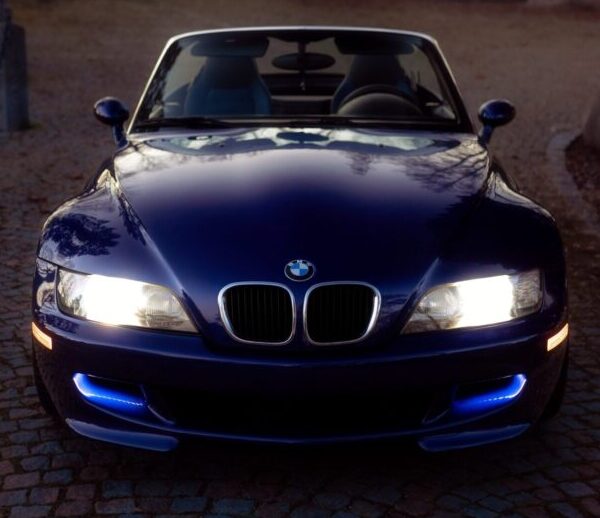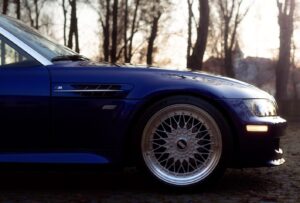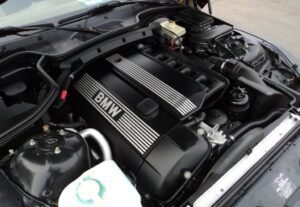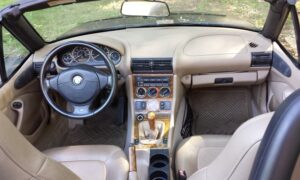BMW Z3 buyers guide
4. Interior
What is BMW Z3?
This is a BMW Z3 buyer’s guide.The BMW Z3 is a sports car model that was produced by the German automaker BMW from 1995 to 2002. It is classified as a compact luxury roadster, which means it’s a small, high-performance convertible designed to emphasize driving enjoyment. The Z3 holds significance as it marked BMW’s re-entry into the roadster market and played a role in shaping the brand’s image as a manufacturer of driver-focused, performance-oriented vehicles.
The Z3’s design is characterized by its sleek and elegant lines, a long front hood, short rear deck, and a generally low-slung stance. It was available in both convertible and later coupe body styles, providing options for different preferences.
The BMW Z3 was introduced to the wider public through its appearance in the James Bond film “GoldenEye,” where it gained considerable attention and contributed to its popularity. This exposure further solidified the Z3’s status as an iconic sports car.
Throughout its production run, the Z3 featured a range of engine options, including four-cylinder and six-cylinder engines, with varying levels of performance. These engines were paired with manual and automatic transmissions, offering drivers a choice between a more engaging driving experience and convenience.
Overall, the BMW Z3 is notable not only for its design and performance characteristics but also for its role in revitalizing interest in roadster-style cars and reaffirming BMW’s commitment to producing vehicles that cater to driving enthusiasts.
Here is a list of BMW Z3 models:
BMW Z3 1.8
BMW Z3 1.9
BMW Z3 2.0
BMW Z3 2.2i
BMW Z3 2.5i
BMW Z3 2.8
BMW Z3 3.0i
BMW Z3 M Roadster
BMW Z3 M Coupe
Body in BMW Z3
The body of the BMW Z3 was designed to capture the essence of a classic roadster with a modern twist. It featured a two-door layout and a compact, agile stance. The body design emphasized a long hood that housed the engine, a short rear deck, and a generally low profile, giving the car a sporty and dynamic appearance.
One of the notable features of the Z3’s body was its construction. The body panels were primarily made from steel, which provided a solid foundation for structural rigidity and safety. However, during its production, BMW introduced some aluminum components to reduce weight and enhance performance. This mix of materials aimed to balance the car’s agility on the road while maintaining safety standards.
The Z3 was most recognizable in its convertible variant, featuring a manually operated soft top that could be opened or closed, allowing drivers to experience the joy of open-air driving. The convertible top design was easy to operate and provided a quick transformation from a closed cabin to an open-top driving experience.
Engine and transmission
The BMW Z3 was offered with a variety of engine options throughout its production run. These engines were designed to provide a balance of power, performance, and efficiency, catering to a range of driving preferences. Here are some key points about the engines used in the Z3:
- Four-Cylinder Engines: The entry-level models of the Z3 were often equipped with four-cylinder engines. These engines were designed to be more fuel-efficient and offered a good balance between power and economy. They were suitable for drivers who wanted a sporty experience while still prioritizing fuel savings.
- Six-Cylinder Engines: The higher-performance variants of the Z3 typically featured inline-six engines. These engines offered more horsepower and torque, resulting in quicker acceleration and a more exhilarating driving experience. They were favored by driving enthusiasts who sought a higher level of performance.
- Engine Displacement: Engine displacement varied across different models and generations of the Z3. Displacement refers to the total volume of air and fuel that can be drawn into all cylinders of the engine. The higher the displacement, the more potential power the engine can produce, generally speaking.
- Naturally Aspirated vs. Forced Induction: Some models of the Z3 featured naturally aspirated engines, which means they relied solely on atmospheric pressure to draw air into the cylinders. Other models were equipped with forced induction, usually in the form of a supercharger or a turbocharger. Forced induction engines provide more air to the cylinders, resulting in increased power output.
- Transmission Options: The engines in the Z3 were mated to a range of transmission options, including manual and automatic transmissions. Manual transmissions offered a more engaging driving experience, allowing drivers to control gear shifts, while automatic transmissions provided convenience for those who preferred an easier driving experience.
- Performance: Depending on the specific engine and model, the BMW Z3’s performance metrics, such as acceleration times and top speeds, varied. Performance-oriented models with larger six-cylinder engines often boasted quicker acceleration and higher top speeds compared to the entry-level models.
Interior
The interior of the BMW Z3 was carefully designed to complement the car’s sporty and driver-centric nature while providing comfort and convenience. Here are more detailed insights into the interior features:
- Cockpit Design: The Z3’s interior was organized around the driver, with controls and instruments oriented for easy access and visibility.
- Seating Comfort: The Z3 featured two well-contoured and supportive seats that provided comfort during spirited driving. These seats were designed to hold the occupants securely in place, especially during cornering and more dynamic maneuvers.
- Materials and Finishes: The interior materials were selected to reflect both luxury and sportiness. Premium materials like high-quality leather, soft-touch surfaces, and brushed aluminum or wood accents were used to enhance the cabin’s aesthetics and tactile appeal.
- Ergonomics: The placement of controls and buttons was carefully considered to ensure they were within easy reach of the driver. This design approach aimed to minimize distractions and allow the driver to focus on the road while accessing essential functions.
- Center Console: The center console housed controls for various functions, such as the audio system, climate control, and more. The layout was designed to be intuitive, allowing the driver to quickly locate and adjust settings without taking their eyes off the road.
- Instrumentation: The instrument cluster featured the essential gauges, including a speedometer and a tachometer. Depending on the model, there might have been additional digital displays for information like fuel level, engine temperature, and trip data.
- Steering Wheel: The steering wheel often featured integrated controls for audio adjustments, cruise control, and other functions. This allowed the driver to keep their hands on the wheel while managing various features.
- Convertible Top Controls: In convertible models, controls for the soft top’s operation were strategically placed, either on the center console or door panels. This made it easy to lower or raise the convertible top for an open-air driving experience.
- Storage Solutions: Given the Z3’s compact size, interior storage was limited but practical. There were compartments for small items, and the trunk, though not large, could accommodate luggage for weekend getaways.
- Sound System: The Z3 could be equipped with various audio systems, ranging from standard setups to premium options. These systems were designed to deliver high-quality sound and entertainment while driving.
Are you already a proud owner of a BMW Z3? If so, check out our selection of parts for this car at the following link:
https://octoclassic.com/product-category/bmw/z3
Photos sources: cargurus.com, gtcarlot.com










